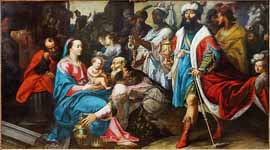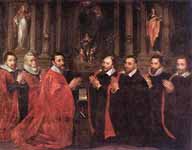Georges Lallemand, or Lallemant





The Échevins of Paris Praying before St Genevičve



Georges and the bowl of broth.
Illustrations

Aeneas saves his father from Troy



The Evangelists Matthew and John
 The Holy Family in an oval frame
The Holy Family in an oval frame
 Sequence of "Christ and the Twelve Apostles ," St. Andrew
Sequence of "Christ and the Twelve Apostles ," St. Andrew
 Sequence of "Christ and the Twelve Apostles ," St. James Major as a pilgrim
Sequence of "Christ and the Twelve Apostles ," St. James Major as a pilgrim
 Sequence of "Christ and the Twelve Apostles ," St. James the Younger
Sequence of "Christ and the Twelve Apostles ," St. James the Younger
 Sequence of "Christ and the Twelve Apostles ," St. John the Evangelist
Sequence of "Christ and the Twelve Apostles ," St. John the Evangelist
 Sequence of "Christ and the Twelve Apostles ," St. Matthew
Sequence of "Christ and the Twelve Apostles ," St. Matthew
 Sequence of "Christ and the Twelve Apostles ," St. Matthias
Sequence of "Christ and the Twelve Apostles ," St. Matthias
 Sequence of "Christ and the Twelve Apostles ," St. Paul
Sequence of "Christ and the Twelve Apostles ," St. Paul
 Sequence of "Christ and the Twelve Apostles ," St. Peter
Sequence of "Christ and the Twelve Apostles ," St. Peter
 Sequence of "Christ and the Twelve Apostles ," St. Philip
Sequence of "Christ and the Twelve Apostles ," St. Philip
 Sequence of "Christ and the Twelve Apostles ," St. Simon
Sequence of "Christ and the Twelve Apostles ," St. Simon
 Sequence of "Christ and the Twelve Apostles ," St. Thaddeus
Sequence of "Christ and the Twelve Apostles ," St. Thaddeus
 Sequence of "Christ and the Twelve Apostles ," St. Thomas
Sequence of "Christ and the Twelve Apostles ," St. Thomas
 Judith with the head of Holofernes
Judith with the head of Holofernes
 Moses with the Tablets of the Law
Moses with the Tablets of the Law
 Moses with the Tablets of the Law
Moses with the Tablets of the Law
Georges Lallemand (before 1575–1636) was a French artist. His name is sometimes given as "Lallemant".
Life
Lallemand was born in Nancy in around 1575.[1] Nothing is known of his artistic education, but he is often assumed to have been a pupil of Jacques Bellange, whose work seems to have had a significant impact on him.[1] He moved to Paris in about 1601 and by 1605 had established a successful studio, where his pupils included Philippe de Champaigne, Laurent de la Hyre and Nicholas Poussin.[2]
His style was eclectic, combining Flemish realist and mannerist influences.[1] Few of his paintings have been traced, much of his work having been dispersed when church property was seized during the French Revolution. His earliest known work, The Mayor and Aldermen of Paris (Musée Carnevalet) dates from 1611.[1] He was appointed Peintre ordinaire du roi in 1626.[1]During the last few years of his life he received commissions for altarpieces and tapestries for the cathedral of Notre Dame, and for six large paintings for the Parisian church of Saint Geneviève-du-Mont.[1] There is an Adoration of the Magi, in the collection of the Palais des Beaux Arts in Lille.[3] and another version of the same subject in the Hermitage.[1]
His work is mostly known from a series of chiaoscuro woodcuts made by Ludolph Büsinck in the 1620s after his smaller religious and genre compositions.[2]
References
Masterworks from the Musée des Beaux–Arts, Lille (Exhibition Catalogue). New York: Metropolitan Museum of Art. 1992. pp. 114– 7. ISBN 978-0810964174.
.̤, Egbert Haverkamp-Begemann (1998). Fifteenth to eighteenth century European drawings : Central Europe, the Netherlands, France, England. New York: Metropolitan Museum of Art [u.a.] p. 296. ISBN 9780691048727.
"L’Adoration des Mages". Palais de Beaux Arts, Lille. Retrieved 31 October 2013.
----
Fine Art Prints | Greeting Cards | Phone Cases | Lifestyle | Face Masks | Men's , Women' Apparel | Home Decor | jigsaw puzzles | Notebooks | Tapestries | ...
----
Artist
A - B - C - D - E - F - G - H - I - J - K - L - M -
N - O - P - Q - R - S - T - U - V - W - X - Y - Z
Retrieved from "http://en.wikipedia.org/"
All text is available under the terms of the GNU Free Documentation License





